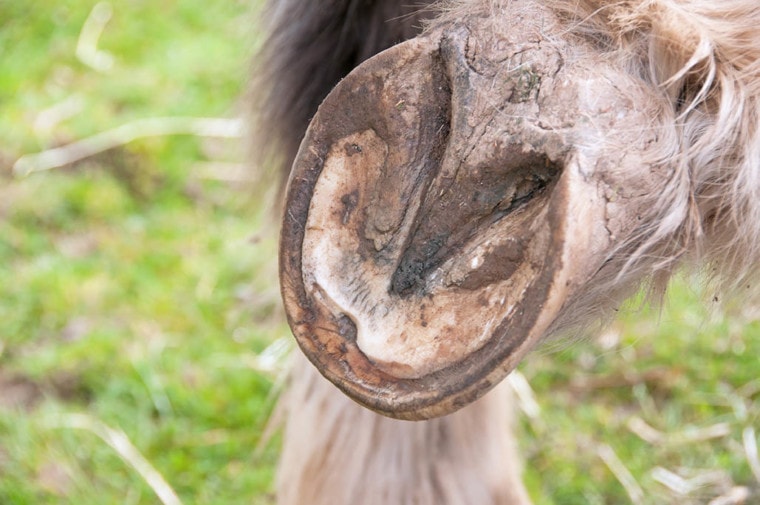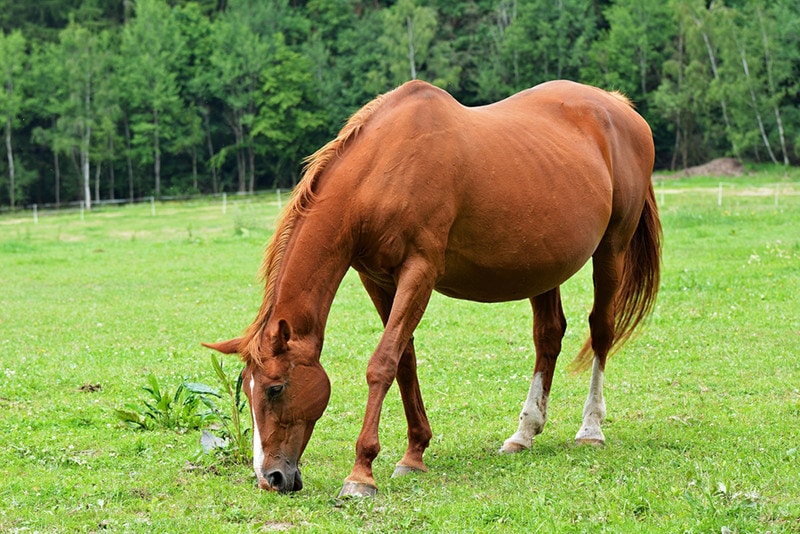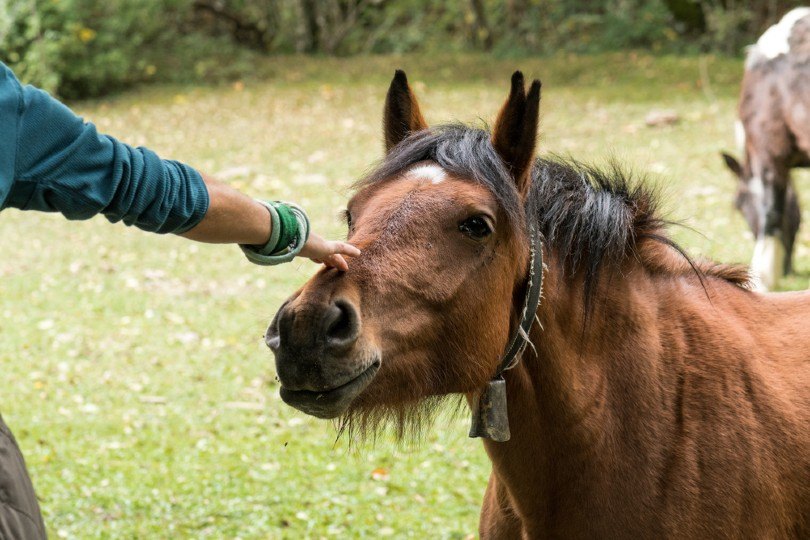
Horses are hardy creatures overall, so it can be a surprise when your horse suddenly appears to be lame when they were perfectly healthy the day before. Any health concerns regarding your horse can be worrisome, but when your horse is suddenly unable to walk for no apparent and obvious reason, it’s a major cause for concern.
When this occurs, the problem is often a hoof abscess. Hoof abscesses are rather common in horses, and they can turn a healthy horse lame in a matter of hours.
While dangerous and scary sounding, hoof abscesses can usually be cured quite quickly with proper treatment. Of course, it’s best to prevent them altogether, though that’s not always possible. Still, we discuss here the best ways to avoid hoof abscesses, what they are, and how to identify and treat them.
What Is a Hoof Abscess?
An abscess in a horse’s hoof is similar to an abscess that you yourself may have had before or seen on someone else. Essentially, it’s a bubble of pus beneath the skin or in this case, in a hoof. As the bubble of pus expands, it creates painful pressure. You can think of it like a giant pimple beneath the surface that doesn’t have a head yet.
All the pus in an abscess is caused by infection. That infection is localized, stuck in a single area that it can’t escape from, though it does grow and become inflamed. The body fights against this, but as the fight continues, so does the swelling, which increases the pain. Within a few days—or perhaps as quickly as a few hours—the swelling gets so bad that your horse can no longer put weight on their foot without experiencing agonizing levels of pain.

Common Causes of Hoof Abscesses
Pimples seem to appear out of nowhere, and abscesses often seem to pop up in the same manner. However, even though it appears to happen at random, there’s always an underlying cause. In the case of abscesses, it’s usually bacteria somehow getting inside the hoof wall. Injuries and abrasions can make this happen, along with environmental factors. Here are the most common culprits that cause hoof abscesses.
Dirty Stall Conditions
Bacterial infections generally cause hoof abscesses, and if your horse’s living conditions are full of filth, there are many more bacteria around. This is why it’s so important to muck the mess out of your horse’s stall and keep it as sanitary as possible. The worst is a wet stall. When the moisture combines with all the mess, it becomes a breeding ground for bacteria that can easily cause abscesses and worse.
Wounds and Injuries
For an infection to set in, the bacteria need a way to get inside the hoof. Wounds and injuries make this possible. They can be small or large, but any type of penetrating wound on the hoof can enable bacteria to enter. If your horse stepped on a rock and got a small puncture in their hoof, mud and dirt can then seal bacteria inside, and an abscess may result in just a few days.

Shoe Nails
The nails in your horse’s shoes must be perfectly placed. If they’re too close to the sensitive inner structures of the foot, they can become an entry point for bacteria, which leads to the possibility of an abscess. Even if a nail was poorly placed during shoeing but removed immediately, it can still leave a pathway for bacteria to follow, which could become an abscess later.
Poor Ground Conditions
If your horse is constantly on rocky, muddy ground, this can cause an infection. Muddy ground can soften your horse’s hooves, making it easier for rocks to cause bruising. Bruised areas in the hooves allow for greater bacterial production, which means a higher likelihood of developing an abscess.
Incorrect Hoof Balance
Should any part of your horse’s foot be left longer than normal, it will accumulate more damage during normal movement, which can create bruising and damage that leads to abscesses. If the walls of your horse’s hooves flare, it can cause excess stress that leads to cracking. Cracks become entryways for bacteria to get into the hoof, bringing along the potential for infection.
Thin Soles With Hot Shoes
If a hot shoe is fit on a thin sole, it can cause heat-related injury to the sensitive tissues of the hoof. Unlike other ways that abscesses are created in your horse’s hooves, this creates a sterile abscess, which means that it’s not caused by an infection. Using heat in the process of repairing a horse’s hoof can lead to the same outcome when performed over raw or only partially healed parts of the hoof.
Cycling Environmental Conditions
When the weather is switching between wet and dry conditions, it can often lead to hoof abscesses. During the dry weather, the hoof shrinks and cracks. Soon, it gets wet again, creating the sort of conditions that bacteria thrive in. The bacteria are able to use those cracks in the hooves as doorways to crawl inside, infecting the hoof and creating an abscess.
Clinical Signs
Before you can do anything to treat an abscess, you have to identify that as the underlying cause of your horse’s lameness. Many other things can cause lameness, and it won’t do you any good to treat an abscess that doesn’t exist. Here are the signs that can help you identify an abscess in your horse’s hoof:
These signs can help you identify a possible hoof abscess, but they don’t serve as a proper diagnosis. If you believe that your horse has a hoof abscess, you’ll need to call a vet who can use a radiograph or a hoof tester exam to officially diagnose the abscess before offering a treatment plan.
How to Treat a Hoof Abscess
How do you treat your pimples when they appear? Most people simply pop them and drain out the pus. The same approach works with abscesses. Open them up, and the pus and infection will drain out. If you’re lucky, an abscess might pop on its own accord, without the need for cutting it open. In horses, when the abscess pops on its own, it’s usually because the pus has reached a thinner part of the hoof wall, such as the heel bulb or coronary band.
When draining an abscess, even if it drains on its own, the most important thing to consider is cleanliness. If you don’t thoroughly clean the area, a new infection will set in right away. When you have to forcefully drain the abscess, you’ll want to clean it before you even consider making a puncture.
Generally, your vet will want to drain the abscess through the sole. This enables gravity to help pull out the pus so a new infection can’t take hold. Also, the original fissure that enabled bacteria to enter in the first place is likely there, and this can usually be used as a pathway to reach the abscess for draining.
In addition to draining and cleaning the abscess, your vet will wrap up the foot to protect it from the possibility of another infection. If necessary, your vet might prescribe antibiotics or anti-inflammatory medications to further aid in healing.
If the abscess is severe, a good portion of the hoof might have to be removed to drain the infection. This would lead to a longer healing term, with additional foot protection needed. For the most part, minor infections heal quickly, but major abscesses that can affect tendons, bones, and joints are more serious and could lead to longer healing and worse outcomes overall.

Prevention
The best way to prevent hoof abscesses is to provide ample foot care for your horses and keep their living conditions clean and sanitary. Find a good farrier, and make sure you get your horses’ feet taken care of every 6 to 8 weeks. This includes trimming to prevent wall separations and shoes for horses with thin soles. All horses will also need regular foot cleaning to keep mud and rocks out of their hooves. Keep the stalls dry and as clean as possible to prevent the possibility of bacterial infection.
Final Thoughts
If you spot the signs of a hoof abscess, time is of the essence. Don’t wait to see how things progress. Call your vet immediately and get a professional diagnosis. The sooner you take care of it, the better the chances of your horse making a full and speedy recovery. If the abscess manages to infect bones, tendons, and joints, the recovery process will be much longer and more painful. It’s best to stay up on your horse’s routine foot care and ensure that their living spaces are sufficiently clean to try to prevent hoof abscesses from occurring at all.
See also:
- Colic in Horses: Vet-Approved Causes, Signs & Treatment Explanation
- Normal Horse Body Temperature, Vital Signs & Health Indicators
- Why Do Horses Need Shoes? Purposes & Risks Explained
Featured Image Credit: Chelle129, Shutterstock








